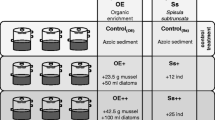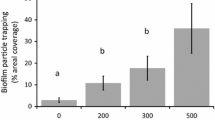Abstract
Six species of benthic diatoms and a natural benthic diatom community were cultured in flasks on a variety of sediments. Diatom species which secreted large quantities of mucilage were effective sediment stabilizers. These mucilage-secreting species significantly reduced resuspension and retarded laminar flow of the sediments when the culture flasks were agitated. Diatom species which secreted little or no mucilage were not effective sediment stabilizers. These non-mucilage-secreting species did not significantly effect resuspension or laminar flow of the sediments when the culture flasks were agitated. A sediment stabilizing mechanism based on the secretion of mucilage by pennate benthic diatoms is proposed. The effect such a process may have on distributional patterns of benthic invertebrates in areas where extensive diatom or other microalgal films occur is discussed.
Similar content being viewed by others
Literature Cited
Bathurst, R.G.C.: Subtidal gelationous mat, sand stabilizer and food, Great Bahama Bank. J. Geol. 75, 736–738 (1967)
Callame, B. et J. Debyser: Observations sur les mouvements des diatomées à la surface des sédiments marins de la zone intercotidale. Vie Milieu 5, 242–249 (1954)
Carter, N.: A comparative study of the algal flora of two salt marshes. Part I. J. Ecol. 20, 341–370 (1932)
— A comparative study of the algal flora of two salt marshes. Part II. J. Ecol. 21, 128–208 (1933a)
—: A comparative study of the algal flora of two salt marshes. Part III. J. Ecol. 21, 385–403 (1933b)
Chapman, V.J.: Studies in salt marsh ecology. Sections IV-V. J. Ecol. 27, 160–201 (1939)
Coull, B.C.: Shallow water meiobenthos of the Bermuda Platform. Oecologia (Berl.) 4, 325–327 (1970)
Drum, R.W. and J.T. Hopkins: Diatom locomotion: an explanation. Protoplasma 62, 1–33 (1966)
Fauré-Fremiet, E.: The tidal rhythm of the diatom Hantzschia. Biol. Bull. mar. biol. Lab., Woods Hole 100, 173–177 (1951)
Frankel, L. and D.J. Mead: Mucilaginous matrix of some estuarine sands in Connecticut. J. sedim. Petrol. 43, 1090–1095 (1973)
Gebelein, C.D.: Distribution, morphology, and accretion rate of recent subtidal algal stromatolites, Bermuda. J. sedim. Petrol. 39, 32–49 (1969)
Ginsburg, R.N. and H.Z. Lowenstam: The influence of marine bottom communities on the depositional environment of sediments. J. Geol. 66, 310–318 (1958)
Gordon, R. and R.W. Drum: A capillarity mechanism for diatom gliding locomotion. Proc. natn. Acad. Sci. U.S.A. 67, 338–344 (1970)
Guillard, R.R.L. and J.H. Ryther: Studies on marine planktonic diatoms. I. Cyclotella nana Hustedt and Detonula confervacea (Cleve) Gran. Can. J. Microbiol. 8, 229–239 (1962)
Johnson, R.G.: Animal-sediment relations in shallow water benthic communities. Mar. Geol. 11, 93–104 (1971)
Krumbein, W.C. and F.J. Pettijohn: Manual of sedimentary petrography, 549 pp. New York: Appleton-Century-Crofts, Inc. 1938
Neumann, A.C., C.D. Gebelein and G.P. Scoffin: The composition, structure, and erodability of subtidal mats, Abaco, Bahamas. J. sedim. Petrol. 40, 274–297 (1970)
Rhoads, D.C. and D.K. Young: The influence of deposit feeding organisms on sediment stability and community trophic structure. J. mar. Res. 28, 150–178 (1970)
Round, F.E. and J.D. Palmer: Persistent, verticalmigration rhythms in benthic microflora. II, Field and laboratory studies on diatoms from the banks of the River Avon. J. mar. biol. Ass. U.K. 46, 191–214 (1966)
Scoffin, T.P.: The trapping and binding of subtidal carbonate sediments by marine vegetation in Bimini lagoon, Bahamas. J. sedim. Petrol. 40, 249–273 (1970)
Strickland, J.D.H. and T.R. Parsons: A practical handbook of seawater analysis. Bull. Fish. Res. Ed Can. 167, 1–311 (1968)
Van Straaten, L.M.J.U. and Ph.H. Kuenen: Tidal action as a cause of clay accumulation. J. sedim. Petrol. 28, 406–413 (1958)
Williams, R.B.: The ecology of diatom populations in a Georgia salt marsh, 146 pp. Ph.D. Dissertation, Cambridge, Massachusetts: Harvard University 1962
— Unusual motility of tube-dwelling pennate diatoms. J. Phycol. 1, 145–147 (1965)
Young, D.K. and D.C. Rhoads: Animal-sediment relations in Cape Cod Bay, Massachusetts. I. A transect study. Mar. Biol. 11, 242–254 (1971)
Author information
Authors and Affiliations
Additional information
Communicated by J. Bunt, Miami
This work was supported by the Belle W. Baruch Foundation, and is Contribution No. 68 of the Belle W. Baruch Institute for Marine Biology and Coastal Research.
Rights and permissions
About this article
Cite this article
Holland, A.F., Zingmark, R.G. & Dean, J.M. Quantitative evidence concerning the stabilization of sediments by marine benthic diatoms. Marine Biology 27, 191–196 (1974). https://doi.org/10.1007/BF00391943
Accepted:
Issue Date:
DOI: https://doi.org/10.1007/BF00391943




